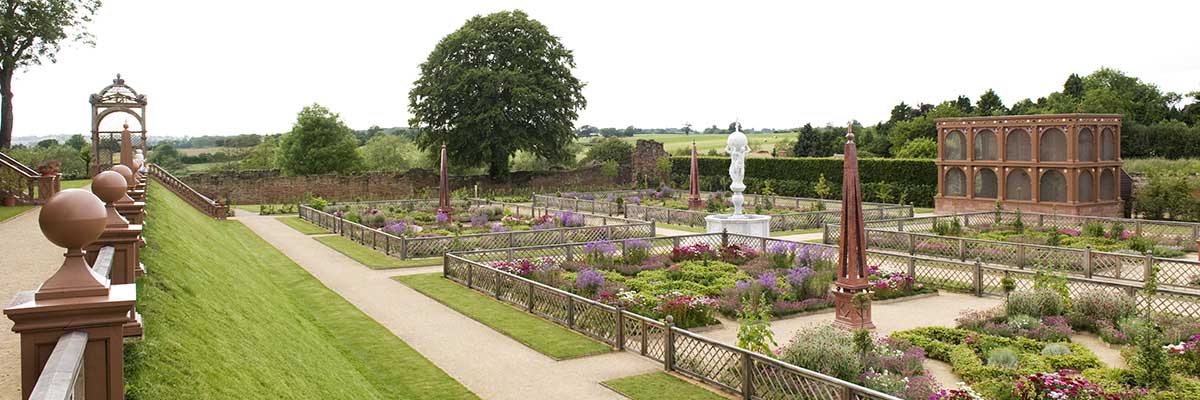Research on Kenilworth Castle
Kenilworth Castle has had an unusually long record of academic research. William Dugdale’s 1656 history of Warwickshire is still an important reference work in its own right and has provided a rich quarry for much of what has been published about Kenilworth since.[1] Like the Kenilworth entry in volume six of the Victoria County History (published in 1951), it is all the more important because it considers the castle in the context of its wider landscape and neighbouring properties.[2]

Romance Versus Scholarship
In the 19th century, thanks to the popularity of Sir Walter Scott’s Kenilworth (1821), works tended to focus on Kenilworth in the age of Robert Dudley, for example, George Adlard’s useful miscellany Amy Robsarte and the Earl of Leycester and a History of Kenilworth Castle.[3] The visitors flocking to the castle were provided with a series of guides, exceptional among which is the wide-ranging and scholarly account by the Revd EH Knowles.[4]
By contrast the generation of historians who worked on the castle after it came into state care in 1937 were much more interested in the Middle Ages, reflecting both the principal interest of the Office of Works and the astonishing quality of the surviving medieval structures. The Office of Works historian John H Harvey, who would become the eminence grise of medieval architectural history, published an influential article on Kenilworth in the later Middle Ages, which included a range of transcripts of documents.[5] A short complementary piece focusing on the preceding period was published subsequently by R Allen Brown.[6]
The standard modern scholarly history of the castle under royal ownership is found in the volumes of The History of the King’s Works covering the period to the mid-15th century and the Tudor period.[7]
Archaeological Work
A range of archaeological investigations took place in the 20th century after the castle passed into state ownership. These included investigations in:
- the outer court (in connection with clearance)[8]
- the tiltyard (prompted in part by the transfer of the main visitor entrance from the north to the south in the 1960s)[9]
- the Pleasance
- the area north of the keep, where extensive digging in search of the Elizabethan privy garden took place in the late 1960s and 1970s.[10]
Michael Thompson was a key figure in many of these excavations. He published an article on the great hall, the thesis of which remains a subject of debate.[11]
Recent Research
The early 21st century witnessed a flurry of new research. This included Simon Adams’s important work on Robert Dudley, based on extensive archival research, and Richard Morris’s work on the castle, based on close examination of the built remains.[12]
Re-presentation of parts of the castle has prompted further work, including detailed analysis of the gatehouse. Extensive work, including archaeological excavation in 2005–6, was also undertaken to inform the recreation of the privy garden in 2008.
Research Gaps
Among the areas of the castle’s history that are less well understood are:
- the history of the site before Geoffrey de Clinton
- the form and development of the castle’s parks and landscape in the Middle Ages and early modern period
- the nature of the building complex at the Pleasance
- the development of the castle and landscape during the 14th and 15th centuries, reconsidering the duchy of Lancaster accounts alongside the surviving building evidence
- the relationship between the castle and priory
- the dismantling of the estate in the mid-17th century
- the treatment of the fabric during the 18th and 19th centuries
- the role of the castle in the Romantic movement
- the conservation work carried out by the Ministry of Works in the 1940s and later.
READ MORE ABOUT KENILWORTH CASTLE
Footnotes
1. W Dugdale, The Antiquities of Warwickshire Illustrated: From Records, Leiger-Books, Manuscripts, Charters, Evidences, Tombes, and Armes: Beautified With Maps, Prospects and Portraictures (London, 1656) (accessed 26 August 2014).
2. LF Salzman (ed), The Victoria History of the County of Warwick, vol 6 (London, 1951) (accessed 26 August 2014).
3. Published London, 1970.
4. EH Knowles, The Castle of Kenilworth: A Handbook for Visitors (Warwick, 1872).
5. JH Harvey, ‘Side-lights on Kenilworth Castle’, Archaeological Journal, 101 (1944), 91–107 (accessed 26 August 2014).
6. RA Brown, ‘A note on Kenilworth Castle: the change to royal ownership’, Archaeological Journal, 110 (1953), 120–24 (accessed 26 August 2014).
7. RA Brown, HM Colvin and AJ Taylor, The History of the King's Works: The Middle Ages, 2 vols (London, 1963), vol 2, 682–5; HM Colvin (ed), The History of the King's Works: 1485–1660, 2 vols (London, 1975/1982).
8. P Rahtz, ‘Kenilworth Castle, 1960’, Transactions and Proceedings of the Birmingham and Warwickshire Archaeological Society, 81 (1963–4), 55–73.
9. MW Thompson, ‘Two levels of the mere at Kenilworth Castle, Warwickshire’, Medieval Archaeology, 9 (1965), 156–61 (accessed 26 August 2014).
10. MW Thompson, ‘The reclamation of waste ground for the Pleasance at Kenilworth Castle, Warwickshire’, Medieval Archaeology, 8 (1964), 222–3 (accessed 26 August 2014); P Ellis (ed), ‘The Elizabethan gardens and Leicester’s stables at Kenilworth Castle’, Transactions and Proceedings of the Birmingham and Warwickshire Archaeological Society, 99 (1995), 81–116.
11. MW Thompson, ‘Three stages in the construction of the hall at Kenilworth Castle, Warwickshire’, in Ancient Monuments and their Interpretation: Essays Presented to AJ Taylor, ed MR Apted, R Gilyard-Beer and AD Saunders (London, 1977), 211–18.
12. S Adams, “Because I am of that countrye & mynde to plant myself there”: Robert Dudley, Earl of Leicester and the West Midlands’, Midland History, 20 (1995), 21–74 (subscription required; accessed 26 August 2014); S Adams, The Household Accounts and Disbursement Books of Robert Dudley, Earl of Leicester, 1558–1561, 1584–1586, Camden Society, 5th Series, 6 (Cambridge, 1995); RK Morris, ‘“I Was Never More in Love with an Olde Howse nor never Newe Worke Coulde be Better Bestowed”: the Earl of Leicester’s remodelling of Kenilworth Castle for Queen Elizabeth I’, Antiquaries Journal, 89 (2009), 241–305 (subscription required; accessed 26 August 2014).